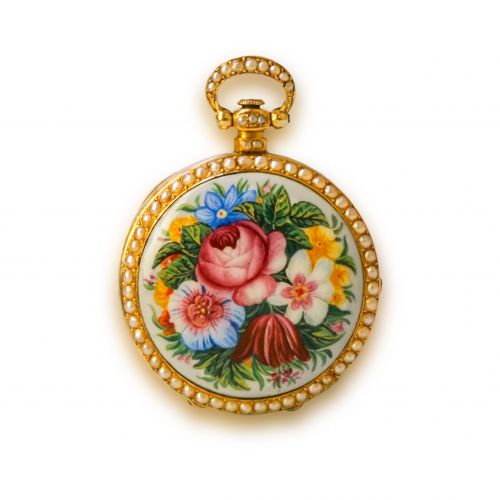Dimier Chinese Market Enamel Painting Pocket Watch
Inventory Number: PW2303003LC
Made in Fleurier, Switzerland, circa 1820, signed Dimier. 29mm, 18K red gold case with pearl-set. The painted enamel scene depicts summer flower bouquets. Case no. 6, white enamel dial with Roman numerals. Gilt full plate movement, fully engraved with foliate decoration, fusee and chain, verge escapement, three-arm balance, pierced and engraved balance bridge, glazed cuvette.
Functions: hours and minutes.
On loan from the private collection of Mr. Yeung Sau Wong.
Brand History
Jean Antoine Dimier (1795-1863) founded Dimier & Cie. in Geneva in the early 19th century. Later records show that around 1835 the company had its premises at Rue Croix d'Or 27. Dimier specialized in miniature pocket watches in gold and enamel or gilt brass cases that were often decorated with floral enamel ornaments and pearls; the watches were usually intended for the Chinese market. As Chinese customers usually preferred large and impressive watches, Dimier’s miniature timepieces were a rarity in their time.
Jean-Antoine Dimier’s two sons, Charles- Louis (1822-1896) and Auguste-Antoine (1824-1891), the brothers graduated from the Collège de Genève and were then initiated into the art of watchmaking in a factory at Chaux-de- Fonds. Auguste worked as a watchmaker; his brother Charles was a sales director. Charles moved to Canton around 1846 and established the company Dimier & Cie with a special Chinese trademark pronounced Tien Ye(點耶), and Auguste was in charge of the production. Trading was discontinued in 1860, presumably because of the war in China. Charles eventually returned to Switzerland and in 1862 the two brothers moved the business from Fleurier to Geneva.
Glossary of Material Terms
Enamel
A vitreous substance which main component is silica mixed with oxides (transition metals) that create a vast palette of colors. Enamel is used to decorate metal surfaces, gold, silver, and copper.
Painting on the Enamel
A gold or copper plate is coated with base enamel and then fired. The colors are in powder form which the enamel-painter dilutes as and when they are needed using an oily or semi-oily essence, before applying them with a fine brush. Each color is dried and then fired before the next is applied. A work can be fired numerous times.
The Chinese market pocket watch is the pocket watch that was specially made for the Chinese market in the 18th to 19th centuries by European watchmakers. It was originally used as a tribute to the Qing Dynasty royal family and spread among the public gradually. Many cases were generally made of silver, brass, gilt-brass, or silver, and decorated with painted enamel with pearls or precious jewels.
The movements are so-called “Chinese Caliber”, and many of them were engraved with beautiful patterns such as scrolled flowers and foliage, the designs were significantly recognizable. From the Chinese collectors ‘view, these kinds of pocket watches are called "The big-eight pieces”. (There is such a statement that the movement was usually designed to consist of a barrel and seven main components, eight pieces in total, and “eight" is considered as the homonym of "fortune" in Chinese, so they were gradually known as "The big-eight pieces" from the 19th century in Chinese.







